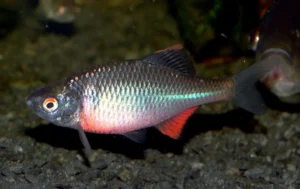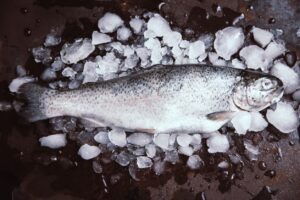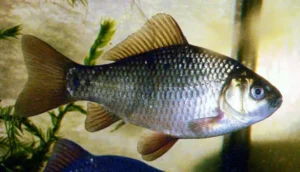Bottom feeder: Common Barbel (Barbus barbus)
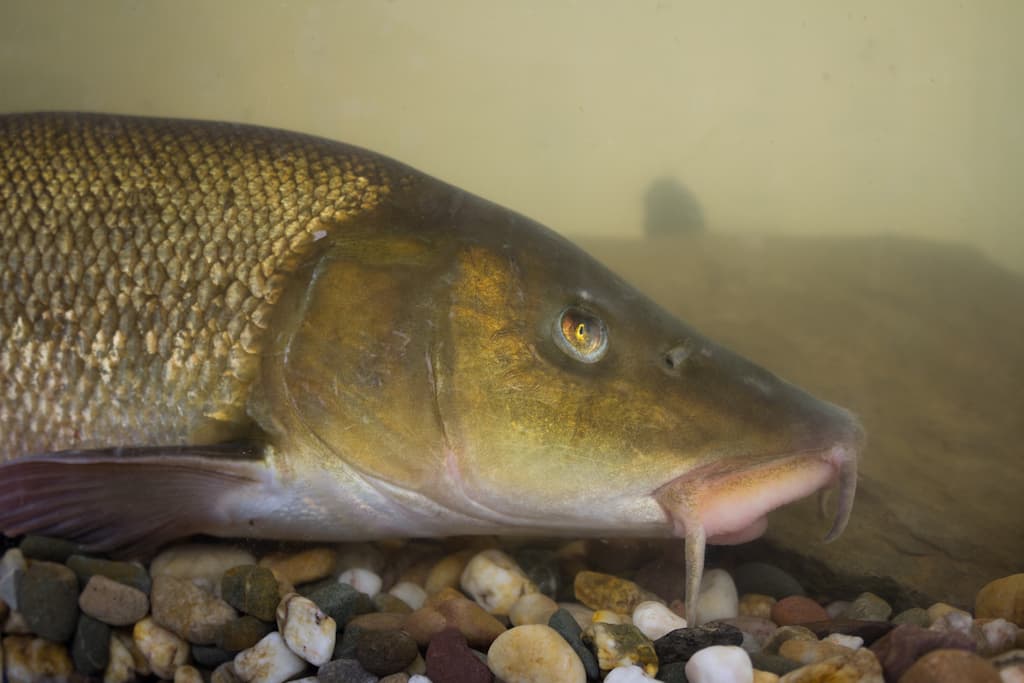
The Common Barbel (Barbus barbus) is one of the most potent fish in our fast-flowing freshwater environments.
Fishing for the Common Barbel can be pretty challenging as it puts up a good fight, and it’s not uncommon to see this solid bottom-dwelling fish perform a leap out of the water in an attempt to free itself.
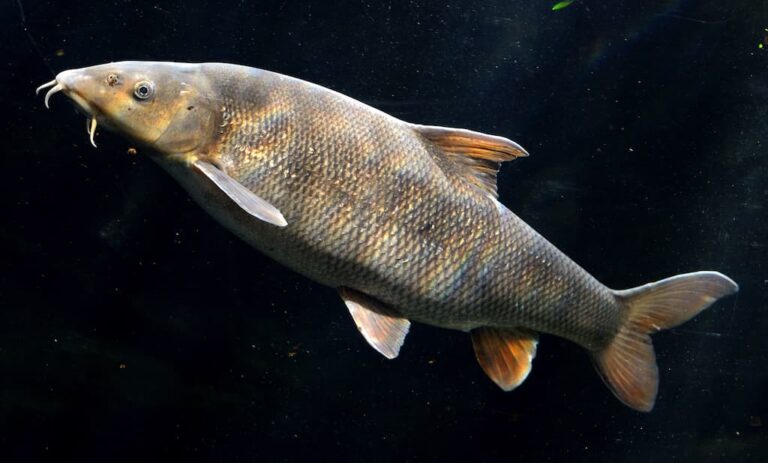
What is a Common Barbel ?
The Common Barbel (Barbus barbus) is a freshwater fish belonging to the family Cyprinidae. It is a popular angler target due to its size and strength, making it an exciting catch for fishing enthusiasts.
Fish description: Common Barbel
Physical characteristics of the Common Barbel
The Common Barbel (Barbus barbus) is a fish with a streamlined body adapted to fast-flowing waters. In cross-section, its body is almost cylindrical with a flat belly.
The Barbel’s head is long, with moderately sized eyes and a small mouth positioned lower down, suited to the fish’s benthic feeding habits. The lips of this fish are thick, with two pairs of barbels attached to the lower lip.
The caudal and anal fins of the Common Barbel are deeply notched. The dorsal fin is relatively short and includes a strongly ossified spine in its posterior part.
The general color of the Barbel varies slightly depending on the color of the water and the riverbed. Its back is generally brown-green but sometimes has a more greyish or golden hue. The sides of the Barbel are silver, speckled with black dots, and its belly is white. The pelvic, caudal, and anal fins are orange, the pectoral fins are yellow, and the dorsal fin is greenish. The body of the Barbel is covered in a multitude of tiny scales.
The typical size of the Common Barbel (Barbus barbus) ranges from 20 to 60 cm (7.9 to 23.6 inches) and weighs between 500 grams and 4 kg (1.1 to 8.8 pounds). The most prominent individuals can reach up to 1.20 meters (3.9 feet) in length and weigh as much as 12 kg (26.5 pounds).
The average lifespan of the Barbel is about 15 years. However, some individuals can live up to an impressive 25 years.
| Class |
| Actinopterygii |
| Order |
| Cypriniformes |
| Family |
| Cyprinidae |
| Genus |
| Barbus |
| Species |
| B. barbus |
| Binomial Name |
| Barbus barbus (Linnaeus, 1758) |
Behavioural traits of the Common Barbel
Common Barbels are primarily bottom feeders, using their barbels to search for food such as insect larvae, crustaceans, and small fish in the substrate of rivers and streams. They are known for their strong swimming abilities, making them a challenging catch for anglers. The male Common Barbel develops small, rough tubercles on its head and pectoral fins during the breeding season, typically in late spring and early summer.
Importance of the Common Barbel in the Ecosystem
The Common Barbel is a keystone species that plays a crucial role in the ecosystem. As bottom feeders, they help maintain the health of aquatic ecosystems by controlling insect and crustacean populations. Additionally, they serve as an essential food source for larger predatory fish, contributing to the overall balance of freshwater ecosystems.
Habitat of the Common Barbel (Barbus barbus)
Natural habitat of the Common Barbel
Common Barbels are found in clear, flowing rivers and streams with gravel or rocky bottoms. They prefer well-oxygenated water and are often found in areas with moderate to fast currents. These fish also inhabit deep pools and rooms with submerged vegetation, providing ample cover and food sources.
Preferred water conditions for the Common Barbel
The Common Barbel thrives in water temperatures ranging from 10°C to 20°C (50°F to 68°F). It is sensitive to pollution and habitat degradation, making clean and unpolluted water essential for survival. Additionally, it requires suitable spawning grounds with gravel or rocky substrates for successful reproduction.
Factors affecting the Common Barbel’s habitat
Human activities such as dam construction, water pollution, and habitat destruction have significantly impacted the natural habitat of the Common Barbels. These factors have led to declining populations in many regions, highlighting the importance of conservation efforts to protect their habitats.
Common Barbel reproduction
Common Barbels reach sexual maturity between 3 and 5 and typically spawn in the late spring or early summer. Female Common Barbels release eggs onto the riverbed during spawning, where the males fertilise them. The fertilised eggs adhere to the gravel or rocky substrate, and the parents do not provide further care for the eggs or the resulting offspring. The survival of the eggs and young fish heavily depends on suitable habitat conditions, emphasising the importance of preserving their natural environment for successful reproduction. Conservation efforts aimed at protecting the spawning grounds and improving water quality are essential for ensuring the continued survival of the Common Barbel population.
Fishing for Common Barbel
Best fishing techniques for catching Common Barbel
Anglers often use bottom fishing techniques when targeting Common Barbel, as they are primarily bottom feeders. Ledgering or float fishing with baits presented on or near the riverbed are effective methods for catching these fish. Additionally, when the fish are most active, fishing during dawn or dusk can increase the chances of a successful catch.
Recommended bait and tackle for Common Barbel fishing
Typical baits for Common Barbel include worms, larvae, and small fish. Regarding tackle, a strong rod and reel setup with a robust line is essential to handle the fish’s powerful runs and dives. A suitable hook size and weight to match the bait and fishing conditions is also crucial for a successful catch.
Regulations and guidelines for fishing Common Barbel
Before embarking on a fishing trip for Common Barbel, anglers need to familiarise themselves with local fishing regulations and policies. This includes obtaining the necessary permits and adhering to catch limits to ensure the sustainability of the fish population.
International name of the Common Barbel
The Common Barbel is known by different names internationally, with “Barbus barbus” being its scientific name. In France, it is referred to as “Barbeau commun,” while in Spain, it is known as “Barbo común.” In Germany, the fish is called “Barbe”; in Italy, it is known as “Barbo comune.” These international names reflect the widespread distribution of the Common Barbel across various European countries and its significance in freshwater ecosystems.
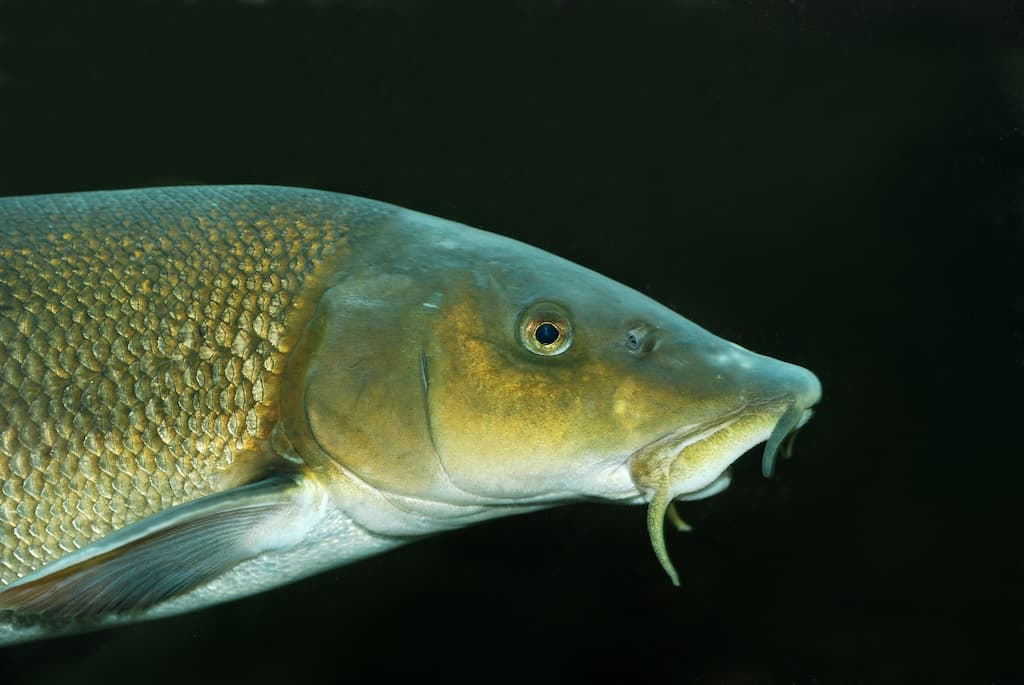
Conservation of the Common Barbel
Threats to the Common Barbel population
The Common Barbel faces various threats to its population, including habitat destruction, water pollution, overfishing, and the construction of dams and weirs that disrupt their natural migratory patterns. These factors have led to a decline in their numbers in many regions. The Common Barbel is considered “LC” (Least Concern) regarding conservation status, as it has a wide distribution and does not face significant threats.
Conservation efforts for the Common Barbel
Conservation efforts for the Common Barbel focus on habitat restoration, water quality improvement, and implementing sustainable fishing practices. Additionally, establishing protected areas and monitoring fish populations are crucial for the long-term conservation of the species.
Ways to support the conservation of the Common Barbel
As fishing enthusiasts, there are several ways to keep the preservation of the Common Barbel. This includes participating in habitat restoration projects, adhering to catch and release practices, and advocating for the protection of rivers and streams that serve as critical habitats for the fish.

